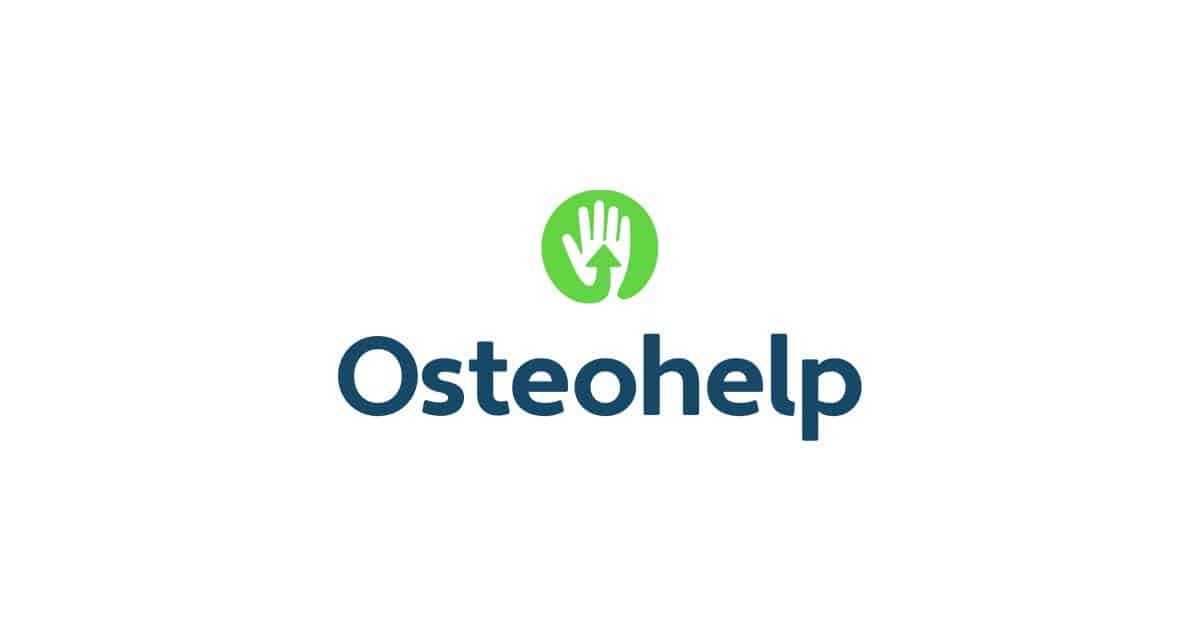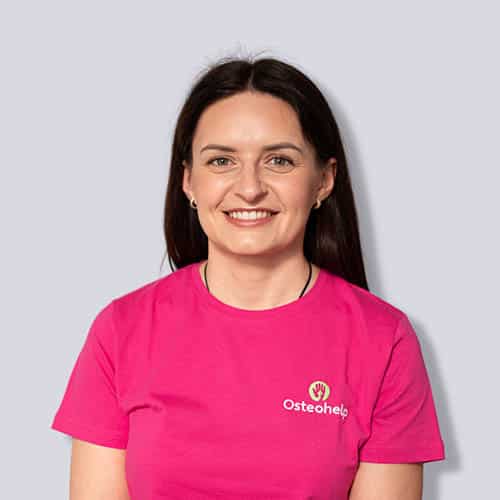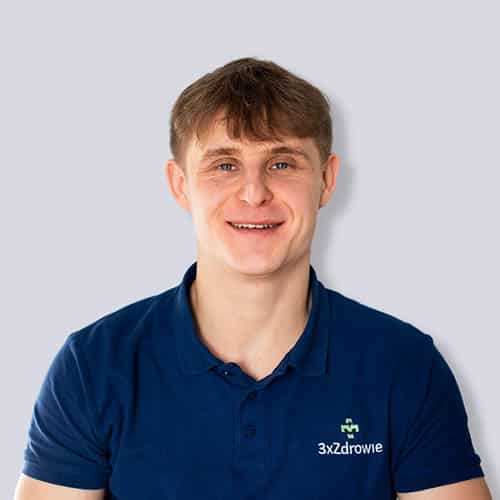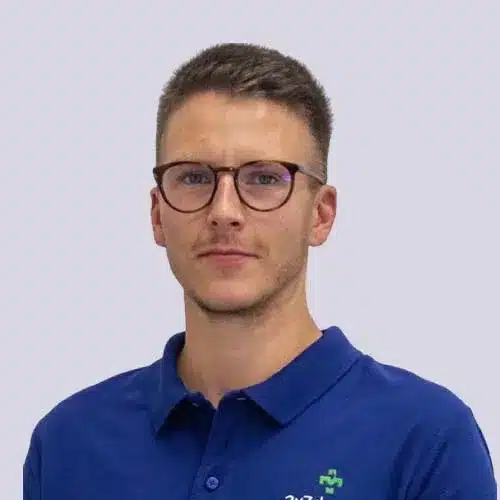Physiotherapy in Krakow.
Physiotherapeutic Diagnostics & Rehabilitation
Our physiotherapy service is characterised by a dynamic and comprehensive approach to any reported problem or body dysfunction.
The therapy is based on a complex system of manual techniques to eliminate pain, spinal and musculoskeletal conditions and psychosomatic symptoms, so as to improve the comfort of patients as quickly as possible.
The overriding aim of comprehensive physiotherapy is not only to eliminate bothersome symptoms, but first and foremost to remove the causes of the symptoms. It is essential to restore patients to the correct movement patterns, to equip them with effective exercises to maintain the therapeutic effects and to prevent the recurrence of the dysfunctions that have developed.
ADDRESS
ul. Limanowskiego 15
30-551 KRAKOW
PRACTICE HOURS
Monday – Friday
8:00 – 21:00
Our physiotherapists use a complex system of examinations and tests to assess the patient’s structural body functions. It does not limit itself to the site of the pain, but uses a compilation of many therapeutic techniques to work out the furthest reaches of its radiation to get to the source of the problem. The diagnosis is also based on an analysis of the patient’s posture and movement patterns and an assessment of their impact on the reported complaints. At our centre, therapists use modern working techniques. Depending on the case, they combine methods appropriately selected for each condition, such as manual therapies, soft tissue and fascial massage, osteopathic techniques, pinotherapy, visceral therapy, cranio-sacral therapy, musculo-fascial therapy, neuromobilization and kinesiotaping-plastering. In addition to manual methods, therapists offer patients individually tailored exercises (kinesiotherapy), such as stabilisation, mobility exercises, proprioception, and also develop specialised sports rehabilitation activities.
Effective physiotherapy
The physiotherapy treatment package we have created includes comprehensive therapy to relieve pain and musculoskeletal conditions. During each session, the therapist uses a compilation of modern manual and diagnostic techniques and exercises.
– Adam Kuk, Physiotherapist and Osteopathic Therapist
Rehabilitation after injury
Post-traumatic rehabilitation concerns the cases of contusions, joint sprains, tendon ruptures or muscle injuries. These are just a few examples of injuries that usually occur during normal, everyday activities. When an injury occurs, diagnostic imaging and appropriate treatment is required. It is important to eliminate symptoms as early as possible and prevent the development of further dysfunctions, especially osteoarthritis, which is difficult to rehabilitate.
Urogynaecological physiotherapy is dedicated to women of all ages. This is an area of rehabilitation focusing on the proper functioning of the muscles of the pelvic region. A urogynaecological physiotherapist helps alleviate urogenital complaints. Among the most common urogynaecological complaints are problems with incontinence, frequent urination, irregular or painful periods or recurrent or chronic inflammation of the lower urinary tract.
Physiotherapy during pregnancy is extremely helpful for women. We use it from the beginning of the 2nd trimester. Safe and well-targeted therapy a few days after birth is effective in preventing unfavourable tension changes and helping the mum’s body to return to shape during the postpartum period. The therapy restores the balance of the endocrine system, supports the healing of caesarean scars, as well as metabolism and lactation. One of the key therapeutic tasks is pelvic stabilisation.
Paediatric physiotherapy helps children improve the range of movement of their muscles and joints, develop appropriate strength, flexibility and movement patterns. Its aim is to make it easier for children to perform daily activities and to ensure optimal musculoskeletal development. It is a non-invasive, painless and highly effective method of treating children’s and infants’ ailments. The therapy has an effect on the child’s nervous system.
Sports physiotherapy deals with the prevention and treatment of injuries related to sport and exercise. Sports injuries are different from other injuries. During intense physical activity, there is more pressure on joints, ligaments, muscles and tendons, which can make them susceptible to all kinds of injuries. Sports physiotherapy is also about supporting post-workout recovery processes, increasing joint mobility, improving muscle strength and preventing injuries and damage during training.
The key to starting to work on postural defects is proper diagnosis, this is what allows us to define the cause of a series of tension disorders in the body. Diagnosis includes an interview and palpation examination. On that basis, the therapists correct the patient’s body misalignment through carefully selected manual therapy and postural muscle strengthening exercises.
Therapeutic and relaxation massage intensely relaxes the muscles and the body and calms the mind. It is the answer to the needs of patients with pain in the spine, shoulder girdle, neck or back muscles. The treatments offered are dedicated, on the one hand, to people leading sedentary lifestyles and, on the other, to patients who are very active, work hard or play sports.
It prepares the patient’s body for surgical procedures and, following surgery, helps with recovery. The physiotherapist manually improves nerve and lymphatic conduction within the organs to be treated. During the wound healing period, the therapy prevents the formation of adhesions, congestion and tension by making the fascial system more flexible.
Helpful therapy for inflammation of joints and ligaments. It involves finding the cause of inflammatory foci in the body and working on musculoskeletal dysfunctions in order to alleviate pain and eliminate discomfort. Indications for physiotherapy therapies include ankylosing spondylitis, psoriatic arthritis, gout, osteoporosis and arthritis.
The main aim of therapy is to improve the overall psycho-physical condition and endurance of the patient affected by the oncological disease. Oncological rehabilitation involves eliminating post-operative lymphoedema, calming the nervous system and restoring mobility after amputations and reconstructions. The essence of oncology physiotherapy is not only to combat pain and restore normal bodily functions, but above all to provide the patient with all-round care, support and to motivate them to take up the fight for themselves.
Physiotherapy dedicated to people affected by cardiovascular problems. Cardiac rehabilitation for patients after a heart attack or heart surgery involves the use of carefully and individually selected therapeutic exercises with a gradual increase in intensity. The aim of the therapy is to shorten the recovery period after cardiac incidents, improve cardiopulmonary efficiency and protect the patient from the dangerous effects of immobilisation and thromboembolic complications.
The rehabilitation is based on individually tailored manual therapies, tissue manipulation, breathing exercises and supportive treatments such as oxygen therapy in a hyperbaric chamber. Comprehensive therapy helps patients return to full physical and mental fitness more quickly. Many of the complications following SARS Cov-2 are associated with hypoxia and systemic inflammation resulting in poor performance, fatigue, shortness of breath, palpitations, excessive sweating, distraction, memory problems or depressive states.
INDIVIDUALISED TREATMENT PLAN
Appointment with a physiotherapist
In our work, establishing a treatment plan is the basis for successful therapy. Therefore, the first appointment starts with a thorough analysis of the disease and its history. At first, the therapist conducts a thorough interview with the patient. Its aim is to find out not only about current ailments and problems, but especially about previous conditions. It is also very important to obtain information on previous treatments.
This is followed by a comprehensive examination of the patient. At the beginning, the therapist looks at the medical records, including MRI, CT scan, X-ray. They then carry out a manual examination. On the basis of all these activities, the therapist establishes an in-depth diagnosis. Finally, the therapist discusses the patient’s problem in detail and presents a plan for further treatment.

HOW CAN WE HELP?
The aim of post-traumatic rehabilitation is to restore the function and efficiency of organs that have been damaged during surgery, trauma or injury. Physiotherapists select the right type of treatments and therapeutic techniques after diagnosing the type of injury or damage to body organs. Their actions aim to restore joint mobility, strengthen muscles and reduce reported discomfort such as pain or swelling. Moreover, physiotherapy can also protect the patient from the risk of re-injury. Post-traumatic rehabilitation is also used for joint arthroscopies and ligament and tendon reconstructions.
Spinal pain is now the most common ailment affecting many of us, regardless of our lifestyle and the way we work. It can occur during the day as well as at night and make daily functioning difficult, also after rest. The accompanying neurological symptoms such as numbness, tingling and sensory disturbances are also common. One of the most effective ways to combat back pain is an appointment with a qualified physiotherapist. Manual therapy, based on a compilation of appropriate techniques, yields excellent results. Its main aim is to relieve pain and restore normal mobility and reduce tissue tension surrounding the spine.
Joint mobilisation techniques are most commonly used for joint pain. Muscle and fascia relaxation techniques are also very helpful. This is because they make it possible to relax the parts of the body that are affected by illness and pain. Physiotherapy also contributes to the recovery of joint mobility and better blood supply to the tissues. As a result, patients very often not only stop struggling with pain, but also notice a significant improvement in their overall body performance. Indications for therapy include restricted joint movement and stiffness, which may have many causes, making the correct diagnosis and rehabilitation so important.
Rehabilitation of balance disorders first and foremost involves an accurate diagnosis to find the causes. In the further therapeutic process, extensive manual techniques are used to restore the correct tension of the soft tissues, improve blood circulation and the proper functioning of the nervous system. Often the physiotherapist also recommends exercises to correct the patient’s posture. Indications for balance therapy may include dizziness, dull hearing, tinnitus, feelings of instability and incorrect positioning in space.
Physiotherapy is extremely helpful in the fight against mobility restrictions and also helps eliminate joint pain. Through accurate diagnosis followed by the implementation of appropriate manual therapy, we work to restore full physiological joint mobility. This is done primarily through the use of appropriate joint mobilisation and musculo-fascial relaxation techniques in therapy. The ultimate goal is to eliminate discomfort and restore full function.
Physiotherapy is crucial in the treatment of postural defects. It focuses primarily on manual techniques and postural training. As a result, the deep muscles are strengthened and the patient gradually adopts a correct posture. Importantly, the effects of physiotherapy in the treatment of postural defects are long-lasting, preventing recurrence of problems. Especially if the specialist combines therapy with patient education. By passing on the knowledge of how to maintain correct posture in everyday life, the therapy significantly reduces the risk of defects and related ailments in the future.











